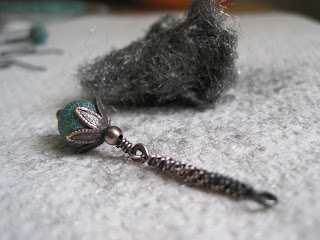The second in a short series of useful tips, this time ~ Oxidising Sterling Silver & Copper jewellery
Whether you oxidise your jewellery or not is a personal choice. I prefer the look of oxidised or "antiqued" Sterling Silver and copper wirework as it adds depth and highlights detail.
What you will need ~
Liver of Sulphur
You can buy Liver of Sulphur in liquid or solid form. I say "solid" but it's really powdery chucks. I prefer the solid form as it is more economical. I buy mine on eBay and it can also be found on jewellery supply sites.

Steel/Wire Wool
0000 or 00000 Grade which can be found in DIY stores
Oxidising your jewellery
Before you start, close the kitchen door and open the back door (wide!) Yes the clue is in the name Sulphur and it stinks like rotten eggs!
Dissolve a small piece of Liver of Sulphur in hot but not boiling water in a small bowl. I keep a bowl especially for oxidising. Avoid touching the Liver of Sulphur if you can help it, it doesn't sting if it comes into contact with your skin but does make your skin tingle for a short while. Always wash your hands if they come into conatct with the Liver of Sulphur. Use a spoon or old pair of flatnose pliers to handle the Liver of Sulphur or gloves if preferred.
Drop your jewellery into the bowl. Copper oxidises very quickly, Sterling Silver takes a bit longer.
Once the jewellery has turned black/grey remove using a spoon/pliers and rinse in a bowl of cold water. Allow to dry on a piece of kitchen roll.
When dry, polish with wire wool over a piece of kitchen roll. This can be quite time~consuming but very therapeutic!When you've finished cleaning with the wirewool check for any stray bits of wire. How much you clean up your jewellery is up to you : some people leave it fairly black, I prefer it well polished. Finish by polishing to a shine with a silver polishing cloth, available from any supermarket.
The End Result
Before
After






Hello,
ReplyDeleteThanks to share your experience with LOS. I am really interested in because i use it a lot. Would you please let me know what you mean by "heat it up in the microwave", and "any longer than a few hours and it loses it's effect". Does it mean there is no more danger if you put it in the microwave after using ?
Sorry but my english is not so good to understand subtilities...
Love your wirework, just delicate and lovely.
xox
Tracy, I am going to try this. The effect is gorgeous and I ordered a heap of copper wire last night! Thanks for the info.
ReplyDeleteAmanda